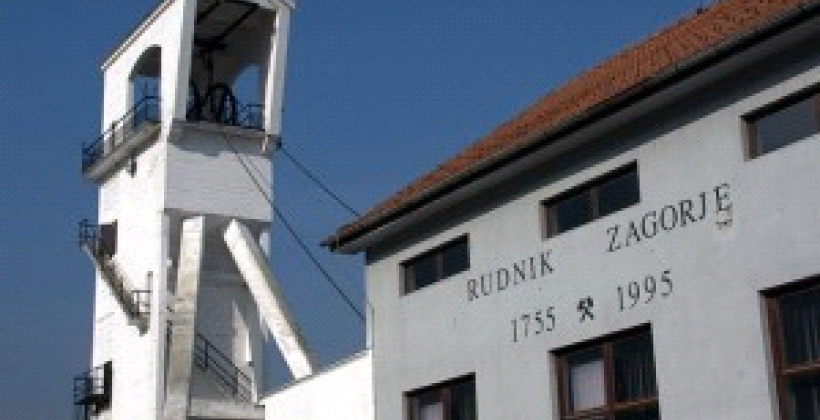
Location
Description
Zagorje is showing that locally available, low-valued renewable energy resources can be capitalized. In Zagorje´s case, it is water from abandoned mines. A system is being put in place that will use geothermal energy from mine-water to heat a youth centre and a primary school. The water has a temperature of around 33 to 34 degrees Celsius and will also be the source of cooling energy that is provided for the commercial buildings and a planned swimming pool.
This project contains 6,000 m² new and 2,000 m² existing buildings using mine water and 1,154 existing houses that are connected to the district heating network fed by a biomass CHP.
Zagorje is part of the CONCERTO project Remining-Lowex Picture 1 - Opening ceremony of the public electrical vehicle charging station Picture 2 - Opening ceremony of the public electrical vehicle charging station Picture 3 - Refurbished building at the demonstration area of Zagorje Picture 4 - OLEA unit from outside Picture 5 - OLEA unit from inside Picture 6 - Vacuum tube collectors Picture 7 - Direct methanol fuel cell
Documents
Site facts and figures
- Estimated population involved: 10,500
- Approx. geographical area coverage: Information will follow
- Approx. energy saving: 227 MWh/y electricity and 5,490 MWh/y heating
- Approx. energy from RES: 2,250 MWh/y electricity and 15,000 MWh/y heating
Technologies
Technologymix
Solar thermal systems are installed at the swimming pool and the youth centre of the town. The youth centre was also equipped with a photovoltaic system of 50 m2. The first solar power plant of the municipality was connected to the country‘s power grid in March 2011. Its capacity is 13.88 kWpeak and an annual production of about 15,000 kWh is predicted.
From 2009 until 2011 there have been two extensions of the district-heating grid: the health centre of Zagorje and the fire brigade building were connected first, followed by an expansion to the Kidričeva street, where two residential and one commercial building were connected. The capacity of biomass boilers (all biomass is provided from local wood industry) feeding the grid has been enlarged to 3 MW and a cogeneration plant (CHP) based on biomass was added. One focus of the project is the use of geothermal energy by mine-water. There are two circuits, one connected to a warm mine-water well, one connected to a cold mine-water well. The first circuit is used for heating a new commerce centre (4,000 m²) and the municipal youth centre (1,350 m²). The second circuit supplies the public swimming pool (2,000 m²) for cooling and dehumidification.
In August 2011, the first charging station for electric vehicles was officially opened (Picture 1). The project’s cooperation with companies should become a model layout of the entire network for charging electric vehicles in Slovenia. Charging of electric vehicles is free for users to encourage the use of electric vehicles.
In the demonstration area 25 of 28 building blocks are already connected to district heating. The 3 blocks with local heating will be connected to the biomass district-heating grid. In all blocks the DHW used to be generated by electric boilers, which now are replaced by heat exchangers connected in the grid. At a certain number of the blocks the building envelope is retrofitted according to CONCERTO standards. The installation of energy monitoring via telemetry was completed in three public buildings. Additionally internal environmental parameters (air temperature and humidity, CO2 concentration) are monitored in order to ensure a healthy indoor environment.
A mobile demonstration unit, called OLEA, was developed (Picture 2). It is a low energy and self-sufficient box and it demonstrates new concepts of low-exergy technologies based on renewable sources.
Overall action plan
The University of Ljubljana (Faculty of Mechanical Engineering, FME) finalised a sustainable energy action plan for the local community of Zagorje. Herein detailed the technical potential of renewable energy sources and energy efficiency measures by sectors is worked out together with an action plan and financial aspects until 2020. The goal was to ensure an energy supply for the community, which is economically and environmentally efficient on the long term. The study incorporates detailed analyses of current consumption and suggestion of measures in buildings (public and private), public lighting, industry, commercial sectors and traffic (see Figure 1 and 2).
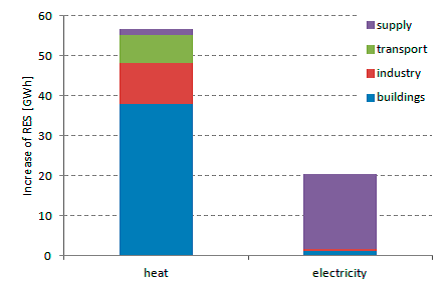
Figure 1 - Increase of Renewable Energy Sources (RES) by energy and sector after action plan realisation
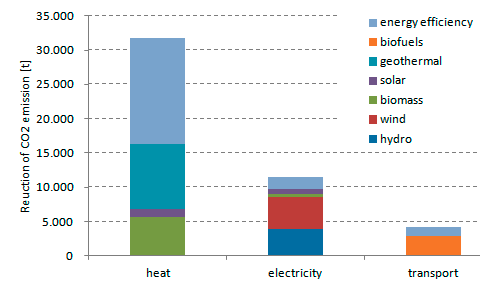
Figure 2 - Reduction of CO2 emission after action plan realisation
Retrofitting residential buildings
From 2009 until 2011 more than 250 existing dwellings were partly retrofitted according to the CONCERTO standard (Picture 3). Energy efficiency was mainly improved by adding additional thermal insulation to the building envelope, by additional attic insulation and by replacement of the old windows. Figure 3 shows reduction of consumed heating energy for the years 2005 until 2010 in Polje Street (after a retrofit in 2009). Figure 4 shows the results of the retrofit at the municipal headquarter buildings in terms of the heating energy consumption.
In the demonstration area there are 28 blocks of which at the current state 25 blocks (1,100 dwellings) are already connected to the district-heating grid (fed by heat from biomass). In a following activity period the building envelope of several blocks will be totally retrofitted. Three blocks with 54 dwellings are not connected yet and have a local heating. They will be connected to the district-heating network. In all building blocks domestic hot water is heated by electric boilers. These electric boilers will be replaced by heat exchangers connected in the grid.
Figure 3 – Normalized consumption of heating energy at Polje Street
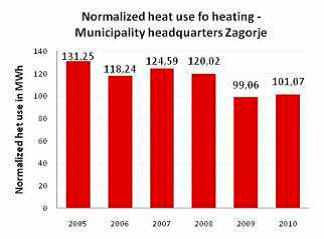
Figure 4 – Normalized consumption of heating energy at the municipal headquarters
The mobile demonstration unit „OLEA“
Research unit OLEA is a low energy self-sufficient mobile unit (Picture 6 and 7). It demonstrates new concepts of low exergy technologies on the base of renewable sources. The unit serves to carry out regular events related to mine water use for heating of buildings, renewable energy exploitation and energy efficiency measures in the built environment.
The presented technological innovations are associated with the culture of mining, at the same time transcending it to show and promote sustainable energy systems. The interiors as well as the envelope of the unit mimic a mining shaft and are adapted to mining architecture. The mining heritage that shaped the region for 250 years is thereby kept alive. The research unit OLEA demonstrates the transition between a black, carbon based history and a green sustainable future in the municipality and wider region.
The unit demonstrates the following technologies:
- Low exergy direct surface heating with mine water (Figure 5)
- Building envelope in passive house standard
- Phase change materials for heat and cold storage
- Solar thermal collectors for sanitary hot water preparation and support of heating (Picture 4)
- Ventilation system with waste air heat recovery with highly efficient regenerators
- Cooling of the building via a ground air heat exchanger
- Energy efficient LED electrical light
- Solar photo voltaic cells and direct methanol fuel cell for electrical self-sufficiency (Picture 5)
- Advanced control systems on the basis of weather forecast and responsive systems management
- Rain water storage
- Dry compost toilet with waste water treatment in constructed wetland
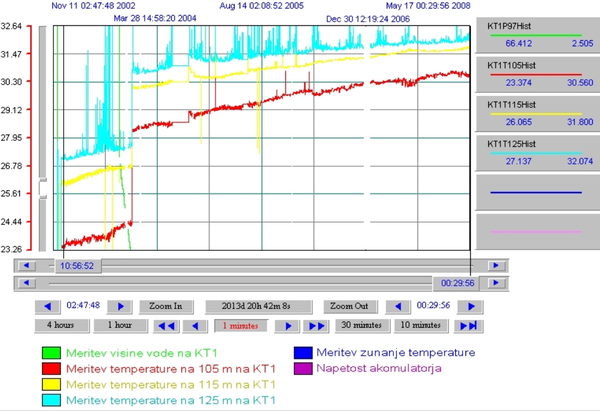
Figure 5 - Measurement of water temperature in the borehole KT1 from November 02 to May 08 at three different depths
The CONCERTO approach
By using renewable energy sources, Zagorje is taking steps to clean itself up and to overcome a reputation of being one of the most polluted towns in Slovenia. The objective is to increase renewable energy supply by 60% compared to standard national practices.
Highlights
Once the retrofitting of the residential buildings has been completed, the community will start to look at what can be done for a number of public buildings. Their energy performance is being monitored and calculations of their energy saving potential are being done, meaning Zagorje will be in an excellent position to further improve its energy performance.
Building aspects
- Building Energy Services
- heating and DHW
- Technology used to supply the buildings
- district heating (DH) network
Thematic Field
- Refurbished Building(s)
